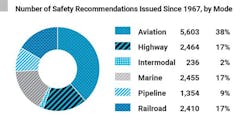NTSB celebrates 50 years of saving lives
Fifty years ago a Lexington Air Taxi Beechcraft D-18 crashed shortly after takeoff from Lexington, Kentucky, fatally injuring nine. It was the first major accident investigated by the newly formed National Transportation Safety Board (NTSB).
In the five decades since the NTSB was created, the agency noted it has investigated thousands of accidents and made more than 14,500 recommendations to improve transportation safety. More than 80 percent of these accident-prevention recommendations have been acted upon favorably, saving countless lives, NTSB added.
“The words ‘From tragedy we draw knowledge to improve the safety of us all’ are etched in glass at the NTSB Training Center,” said NTSB Acting Chairman Robert L. Sumwalt, “and those words guide the agency in its mission to this day.”
Today, the NTSB is charged by Congress with investigating every civil aviation accident in the United States and significant accidents in other modes of transportation—railroad, highway, marine, and pipeline. The NTSB determines the probable cause of the accidents and issues safety recommendations aimed at preventing future accidents.
Now with a staff of 430, the National Transportation Safety Board investigates, on average, 1,600 aviation accidents and incidents, 22 highway crashes, nine rail accidents, three pipeline or hazardous materials accidents, and 30 maritime accidents each year, and issues more than 280 safety recommendations.
“The NTSB has no enforcement or regulatory powers,” the agency explained. “The fact that more than 80 percent of the NTSB's 14,522 safety recommendations since 1967 have been acted upon favorably is a testament to the work of NTSB employees. These safety recommendations have led to significant safety improvements through five decades.”
Fifty years ago, seat belts were not yet mandatory in every state. Seat belts now save about 13,000 lives a year. Likewise, new cars must be equipped with airbags, as well as lap-and-shoulder belts in both the front and back seats, and every state has laws governing mandatory usage of car seats for children.
Fifty years ago, commercial passenger airliner crashes related to encounters with thunderstorms were not uncommon; in fact from 1973 to 1985 seven thunderstorm-related crashes killed 514 people. The NTSB’s investigations identified the need for better thunderstorm detection and led to the agency issuing related safety recommendations. These resulted in the development and use of better storm detection, warning and avoidance technologies. As a result of these and other safety advancements, there has not been a loss of life associated with a thunderstorm-related commercial passenger airline crash since 1999, NTSB said.
Fifty years ago, pressurized rail tank cars exploded when involved in accidents. One explosion, in Waverly, TN, killed 16 and injured 43 in 1978. Following that tragedy, the NTSB recommended improvements, and, just two weeks after the NTSB’s finding that a high-carbon wheel caused the derailment, the Federal Railroad Administration acted to ban all such wheels by the end of the year.
“The work of the NTSB is not just about ships, planes, trains and automobiles – it’s also about the people who travel on them,’’ Sumwalt said. “It’s about the people who work in the transportation industry, and it’s about the people who need help in the aftermath of a transportation disaster.”
It was not until 1996, following the crash of TWA Flight 800, that the need was recognized for a federal agency to have responsibility for facilitating the recovery and identification of fatally injured passengers in a transportation disaster. The Aviation Disaster Family Assistance Act of 1996 and the Rail Passenger Disaster Family Assistance Act of 2008 assigned this responsibility to the NTSB. Today the NTSB’s Transportation Disaster Assistance program provides training to regulated air and rail passenger carriers to ensure they are prepared to provide the vital assistance to survivors and families of victims.
From ground-proximity warning systems on airplanes to center, high-mounted brake lights on automobiles; from “Call Before You Dig” to the recognition of the dangers of fatigue; NTSB findings and recommendations touch every American, and every part of our transportation system.
Looking forward, the challenges of aging infrastructure, high-speed rail, drones, commercial space travel and increased automation in transportation are emerging. The transportation industry is focused on a future with zero accidents as advances in automation present new opportunities to save lives. The NTSB noted it will continue to investigate accidents and make recommendations that will help future generations enjoy an era free from transportation accidents.
“Whatever the future challenges, the NTSB’s tried-and-true method of finding not only what happened in an accident or crash, but why it happened, and issuing safety recommendations with an eye to preventing future accidents, will serve the country well,’’ Sumwalt said. "The work of this agency has made transportation safer yesterday, today and will continue to do so tomorrow.''

